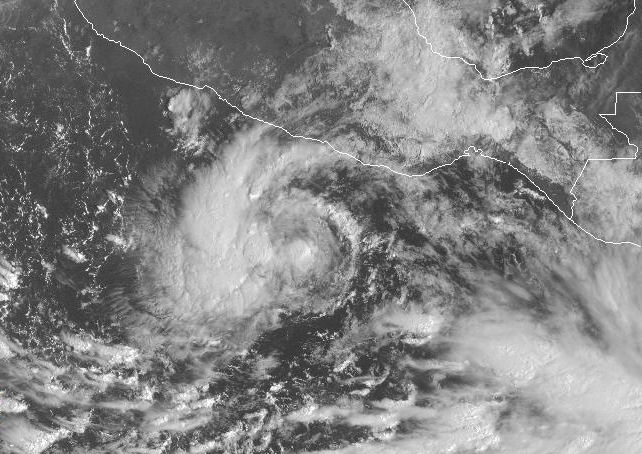|
Timeline Of The 2008 Pacific Hurricane Season
The 2008 Pacific hurricane season officially started on May 15 in the East Pacific Ocean, and on June 1 in the Central Pacific; they both ended on November 30. These dates conventionally delimit the period of each year when most tropical cyclones form in the Pacific basin. The first storm of the year, Tropical Storm Alma, developed on May 29, and the last, Tropical Storm Polo dissipated on November 5.[ This timeline documents all the storm formations, strengthening, weakening, landfalls, extratropical transitions, as well as dissipation. For convenience and clarity, in the timeline below, all landfalls are bolded. The timeline will also include information, when it becomes available, which was not operationally released, meaning that information from post-storm reviews by the National Hurricane Center, such as information on a storm that was not operationally warned on, have been included. The graphical bar below gives a brief overview of storm activity during the season, an ... [...More Info...] [...Related Items...] OR: [Wikipedia] [Google] [Baidu] |
Hurricane Norbert (2008)
Hurricane Norbert is tied with Hurricane Jimena (2009), Hurricane Jimena as the strongest tropical cyclone to strike the west coast of Baja California Sur in recorded history. The fifteenth named storm, seventh hurricane, and second major hurricane of the 2008 Pacific hurricane season, 2008 hurricane season, Norbert originated as a tropical depression from a tropical wave south of Acapulco on October 3. Strong wind shear initially prevented much development, but the cyclone encountered a more favorable environment as it moved westward. On October 5, the National Hurricane Center (NHC) upgraded the depression to Tropical Storm Norbert, and the system intensified further to attain hurricane intensity by October 6. After undergoing a period of rapid deepening, Norbert reached its peak intensity as a Category 4 on the Saffir–Simpson hurricane wind scale, with maximum sustained winds of and a minimum atmospheric pressure, barometric pressure of . As the cyclone rou ... [...More Info...] [...Related Items...] OR: [Wikipedia] [Google] [Baidu] |
Atlantic Oceanographic And Meteorological Laboratory
The Atlantic Oceanographic and Meteorological Laboratory (AOML), a federal research laboratory, is part of the National Oceanic and Atmospheric Administration's (NOAA) Office of Oceanic and Atmospheric Research (OAR), located in Miami in the United States. AOML's research spans tropical cyclone and hurricanes, coastal ecosystems, oceans and human health, climate studies, global carbon systems, and ocean observations. It is one of seven NOAA Research Laboratories (RLs). AOML’s organizational structure consists of an Office of the Director and three scientific research divisions. The Office of the Director oversees the Laboratory’s scientific programs, as well as its financial, administrative, computer, outreach/education, and facility management services. Research programs are augmented by Cooperative Institutes, such as the Cooperative Institute for Marine and Atmospheric Studies (CIMAS), a joint enterprise with the University of Miami’s Rosenstiel School of Marine, Atmosphe ... [...More Info...] [...Related Items...] OR: [Wikipedia] [Google] [Baidu] |
Cabo San Lucas, Mexico
Cabo San Lucas (, "Saint Luke Cape"), or simply just Cabo, is a resort city at the southern tip of the Baja California Peninsula, in the Mexican state of Baja California Sur. As at the 2020 Census, the population of the city was 202,694 inhabitants.2020 Census of Mexico. Cabo San Lucas together with the famous San José del Cabo are collectively known as Los Cabos. Together, they form a metropolitan area of 351,111 inhabitants.2020 Census of Mexico. Rated as one of Mexico's top five tourist destinations, Cabo is known for its beaches, scuba diving locations, Balnearios, the sea arch El Arco de Cabo San Lucas, and marine life. The Los Cabos Corridor has become a heavily trafficked vacation destination for tourists, with numerous resorts and timeshares along the coast between Cabo San Lucas and San José del Cabo. The waters around Cabo are home to marine wildlife including rays, sharks, mahi-mahi (dorado), and striped marlin. History Archaeological excavations have shown evidenc ... [...More Info...] [...Related Items...] OR: [Wikipedia] [Google] [Baidu] |
Genevieve 2008 Track
Genevieve (french: link=no, Sainte Geneviève; la, Sancta Genovefa, Genoveva; 419/422 AD – 502/512 AD) is the patroness saint of Paris in the Catholic The Catholic Church, also known as the Roman Catholic Church, is the largest Christian church, with 1.3 billion baptized Catholics worldwide . It is among the world's oldest and largest international institutions, and has played a ... and Eastern Orthodox Church, Orthodox traditions. Her Calendar of saints, feast is on 3 January. Genevieve was born in Nanterre and moved to Paris (then known as Lutetia) after encountering Germanus of Auxerre and Lupus of Troyes and dedicated herself to a Christian life.McNamara, Halborg, and Whatley 18. In 451 she led a "prayer marathon" that was said to have saved Paris by diverting Attila's Huns away from the city. When the Germanic king Childeric I besieged the city in 464, Genevieve acted as an intermediary between the city and its besiegers, collecting food and convinc ... [...More Info...] [...Related Items...] OR: [Wikipedia] [Google] [Baidu] |


